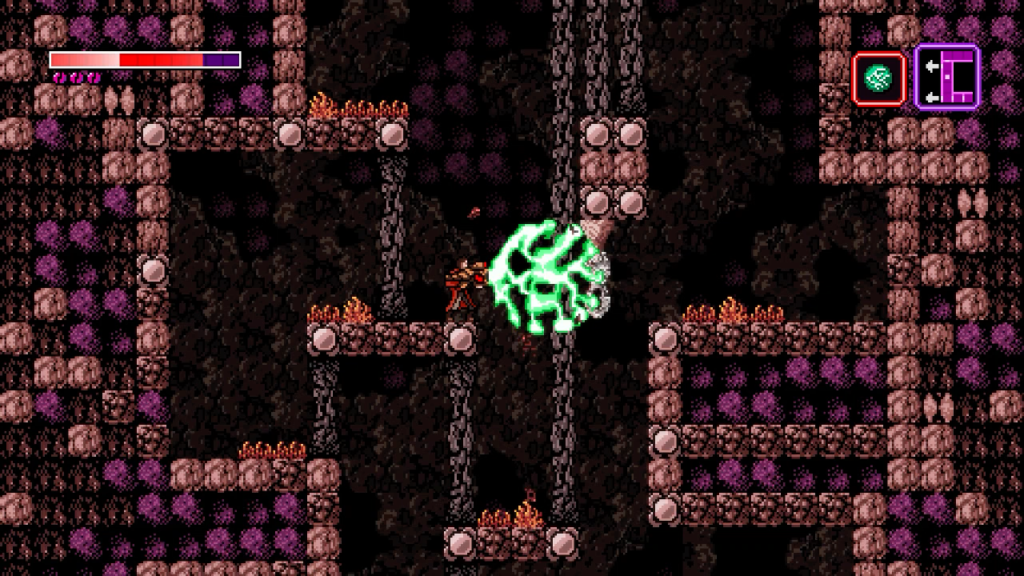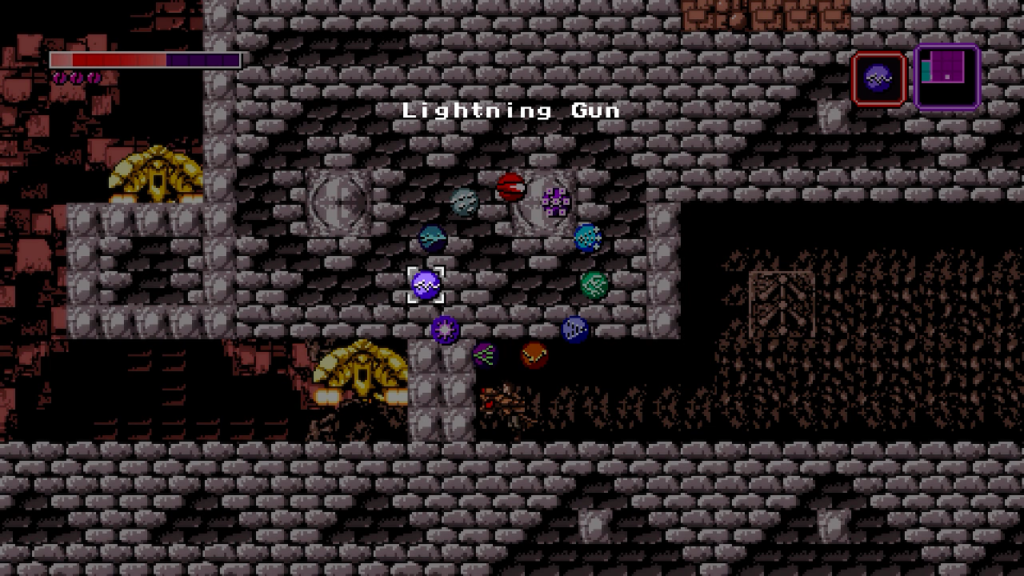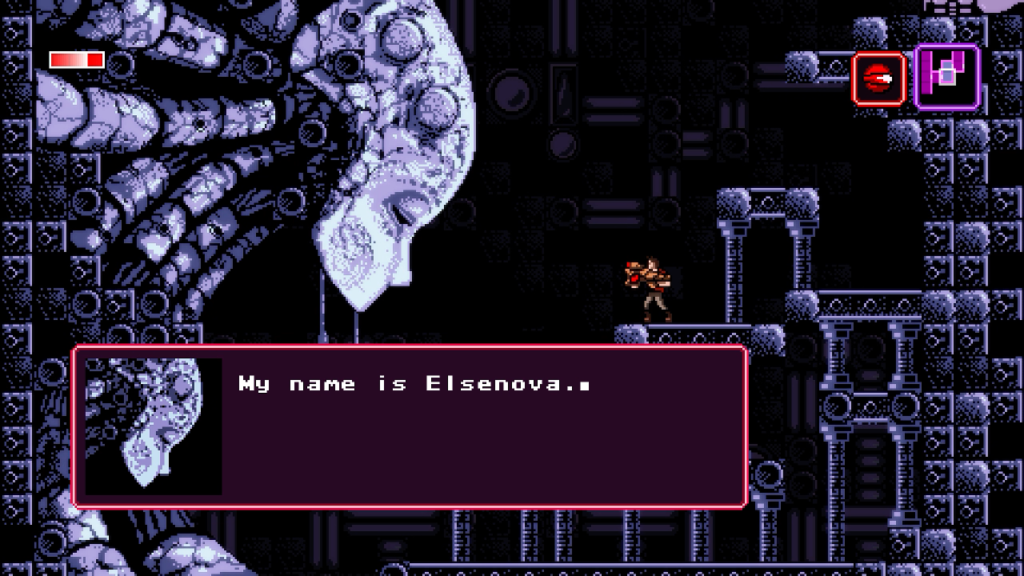Axiom Verge is an adventure platformer inspired by the glitches that were both a plague and a boon for players of classic 8-bit platformers. I play as Trace, a scientist who is knocked out by an explosion in his lab. When Trace awakens, he finds himself on an alien world called Sudra. He is endangered by the machinations of Athetos, a genocidal overlord who has flooded Sudra with a pathogen that overwhelms those it infects with hallucinations. Trace teams up with Sudra’s native inhabitants, the angelic and monstrous Rusalki, to defeat Athetos in the hopes of finding a way back to Earth. This goal is complicated by worsening hallucinations from Athetos’ pathogen and the enigmatic behavior of the Rusalki, who seem to have their own ulterior motives.

From the moment Trace awakens on Sudra, Axiom Verge feels familiar. My typical progress from the screen’s left side to its right is blocked by a solid barrier, but Trace is told by a disembodied woman’s voice to pick up a gun in the room to the left. Upon retrieving the gun, the Axiom Disruptor, I have no other paths but to return to the first room and use my new tool to break down the wall, revealing a door. This simple sequence teaches me that I can explore in any direction to discover new tools, then retrace my steps to apply those tools to previously unsolvable problems.
This is well-trod design, especially in the indie space, which Axiom Verge does almost nothing to expand or variate upon. As I explore Sudra, I discover more tools that open new passages. Diligent exploration uncovers further upgrades that enhance Trace’s health and the Axiom Disruptor’s power. This directly translates exploration of the map into character power; the more time I spend uncovering Sudra’s hidden rooms and clearing its obscure optional chambers, the more pickups I will discover and the easier time I will have with the next boss encounter, culminating in the final showdown with Athetos at the map’s top. It’s a rigorously formulaic experience.

Many of the pickups I find across Sudra are mods for the Axiom Disruptor. Its default firing mode, also called the Disruptor, fires a single red energy burst across the screen. It’s efficient and quick-to-fire and almost always useful. Shortly into my adventure I discover the Kilver mod which fires a short-range burst of energy in front of Trace. It’s essentially a melee attack, but its wide area of effect lets me safely attack enemies around corners and through walls. Disruptor and Kilver, two of the first mods I discover, are almost the only mods I use throughout Axiom Verge.
But there are over twenty Disruptor mods total to discover. Early on I find the Nova mod. When I press the attack button it sends a projectile forward, which explodes when I press the attack button again. This is needed to open some doors in the first area, but it’s the only mod that acts as a progression roadblock, and the level design soon forgets it exists.

Other mods include Shards, which fires a flurry of ice blades through the room; Voranj, which shoots arcing lightning bolts; and the Firewall, which drops walls of fire. None of these guns are useless, but neither are they useful, let alone necessary to progress. At best, they provide some variety to accommodate various tastes and playstyles. I never found a reason to use more than 90% of them, and for me unused pickups are the fastest way to drain joy out of an adventure-platformer. Each discovered mod represents a few decimals closer to one hundred percent completion but not an interesting game-changing tool.
I got a lot more use out of Axiom Verge’s non-weapon upgrades. Early on I discover a drill which lets me break down some walls in the environment. Many of these walls are easy to spot. Most blend in with the environment and can only be discovered by poking a barrier with the drill to see if it crumbles. A good portion of the upgrades are hidden in this way, requiring much random poking of every reachable surface to see if anything happens.

I also discover a remote drone, a spider-like robot that I take control of while Trace remains motionless, protected by a force field. The drone can slip into tiny openings Trace cannot, allowing access to small areas that might hide useful items or new paths forward. It also comes equipped with a mini-drill. This drill can be used to attack enemies but it’s really only meant as a last resort. The mini-drill also means more random wall-poking in the hopes of discovering pickups.
Trace’s most significant upgrades are where Axiom Verge draws its inspiration from 8-bit graphics and performance glitches. Throughout Sudra, I come across platforms that are graphically garbled. These “glitched” graphics change the platforms in different ways; some become impassable barriers, while others refuse to support Trace’s weight. Using an Address Disruptor mod for the Axiom Disruptor, I can “fix” these platforms, creating new paths forward. Whether these graphical “glitches” are a result of Athetos’ pathogenic hallucinations or suggest some darker secret about Sudra is left up to my interpretation.

Another common glitch from the 8-bit era, beloved and exploited by speedrunners, is passing through apparently-solid barriers by moving into them with specific and determined intention. Axiom Verge turns this exploit into design with lab coats which allow Trace to pass through certain walls around Sudra. The latter half of the adventure feels dominated by three of these coats with increasing power and functionality. So few of Trace’s upgrades actually open new passages that when I discover a new lab coat I know I’m ready to make another leap forward in progression.
By combining all of Trace’s skills, I can uncover Axiom Verge’s final homage to classic videogame glitches: glitch worlds. When I travel inside a glitch world I find a small pocket dimension filled with glitched platforms and enemies. Navigating these small labyrinths presents some of Sudra’s greatest challenges as I can trust nothing I see to behave normally. Glitched enemies act with warped patterns and supernatural aggression. Glitched floors and walls cut off obvious paths, forcing me to make detours. These glitch worlds protect some of Sudra’s best upgrades and appear randomly in each save file, ensuring I cannot trust experience or a guide to point me towards all of them.

I play and review a lot of adventure platformers and Axiom Verge stands out among them all as being bland and unambitious. Its map is a large circle I loop my way around counter-clockwise. The few needed examples of backtracking are obvious; when I find a new tool I know immediately where I need to apply it to discover a new path forward. I never feel lost in its world. I never wonder where I need to go next, and I never feel curious to explore Sudra’s nooks and crannies before going there.
Worse than being bland, Axiom Verge is derivative. Every adventure platformer owes its design philosophy to Metroid, but Axiom Verge is too blatant in its homage. That first lesson, that I may travel in any direction I want and backtrack to previously impassable barriers to apply newly discovered tools, is taken directly from Metroid. This concept is so endemic as to be intuitive and most adventure platformers don’t even bother teaching it anymore. It simply isn’t necessary to untrain players from the conventions of Super Mario Bros and Pitfall so many decades after the fact. Sudra is also overly reminiscent of Metroid’s planet Zebes. Only its surface hints at the unique alien world I am exploring, but most of my time is spent underground in drab, ugly caves.

Axiom Verge’s plot is similarly derivative, borrowing in equal parts from Half-Life and BioShock and doing nothing surprising with either of them. Just by mentioning BioShock I have already spoiled Axiom Verge’s biggest twist. The Rusalki are interesting characters with complex motivations but they bely a predictable plot I’ve already seen in other, better videogames.
I don’t enjoy Axiom Verge. Almost everything about it feels like a misfire, even its best ideas. Its world is small, mostly linear, and rarely interesting to look at. There’s an impressive array of weapon mods for the Axiom Disruptor, but I only use two of them. Uncovering hidden passages requires too much blind probing with the drill. The glitches, despite being the nominal point of the entire videogame, ultimately serve as low-impact bridges opened by rudimentary lock-and-key puzzles.

Despite all these personal complaints, Axiom Verge is still commendable as the effort of a solo developer: Tom Happ. It is a single, complete videogame that successfully accomplishes its design goals, if in an uninspired way. I believe he is capable of making a great adventure platformer, he just missed the mark here. He is nearing completion on Axiom Verge 2, which I hope steps out and finds more of its own identity. His first effort lacks one of its own.